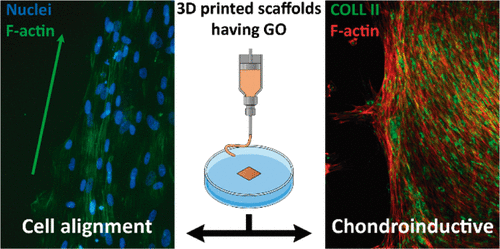当前位置:
X-MOL 学术
›
ACS Appl. Mater. Interfaces
›
论文详情
Our official English website, www.x-mol.net, welcomes your
feedback! (Note: you will need to create a separate account there.)
Chondroinductive Alginate-Based Hydrogels Having Graphene Oxide for 3D Printed Scaffold Fabrication.
ACS Applied Materials & Interfaces ( IF 8.3 ) Pub Date : 2020-01-07 , DOI: 10.1021/acsami.9b22062 Felipe Olate-Moya 1 , Lukas Arens 2 , Manfred Wilhelm 2 , Miguel Angel Mateos-Timoneda 3, 4, 5 , Elisabeth Engel 3, 4, 5 , Humberto Palza 1, 6
ACS Applied Materials & Interfaces ( IF 8.3 ) Pub Date : 2020-01-07 , DOI: 10.1021/acsami.9b22062 Felipe Olate-Moya 1 , Lukas Arens 2 , Manfred Wilhelm 2 , Miguel Angel Mateos-Timoneda 3, 4, 5 , Elisabeth Engel 3, 4, 5 , Humberto Palza 1, 6
Affiliation

|
Scaffolds based on bioconjugated hydrogels are attractive for tissue engineering because they can partly mimic human tissue characteristics. For example, they can further increase their bioactivity with cells. However, most of the hydrogels present problems related to their processability, consequently limiting their use in 3D printing to produce tailor-made scaffolds. The goal of this work is to develop bioconjugated hydrogel nanocomposite inks for 3D printed scaffold fabrication through a micro-extrusion process having improved both biocompatibility and processability. The hydrogel is based on a photocrosslinkable alginate bioconjugated with both gelatin and chondroitin sulfate in order to mimic the cartilage extracellular matrix, while the nanofiller is based on graphene oxide to enhance the printability and cell proliferation. Our results show that the incorporation of graphene oxide into the hydrogel inks considerably improved the shape fidelity and resolution of 3D printed scaffolds because of a faster viscosity recovery post extrusion of the ink. Moreover, the nanocomposite inks produce anisotropic threads after the 3D printing process because of the templating of the graphene oxide liquid crystal. The in vitro proliferation assay of human adipose tissue-derived mesenchymal stem cells (hADMSCs) shows that bioconjugated scaffolds present higher cell proliferation than pure alginate, with the nanocomposites presenting the highest values at long times. Live/Dead assay otherwise displays full viability of hADMSCs adhered on the different scaffolds at day 7. Notably, the scaffolds produced with nanocomposite hydrogel inks were able to guide the cell proliferation following the direction of the 3D printed threads. In addition, the bioconjugated alginate hydrogel matrix induced chondrogenic differentiation without exogenous pro-chondrogenesis factors as concluded from immunostaining after 28 days of culture. This high cytocompatibility and chondroinductive effect toward hADMSCs, together with the improved printability and anisotropic structures, makes these nanocomposite hydrogel inks a promising candidate for cartilage tissue engineering based on 3D printing.
中文翻译:

用于3D打印支架制造的具有氧化石墨烯的软骨诱导藻酸盐基水凝胶。
基于生物共轭水凝胶的支架对组织工程具有吸引力,因为它们可以部分模拟人体组织特征。例如,它们可以进一步增加其对细胞的生物活性。然而,大多数水凝胶存在与它们的可加工性有关的问题,因此限制了它们在3D打印中用于生产定制支架的用途。这项工作的目标是通过具有改善的生物相容性和可加工性的微挤出工艺来开发用于3D打印支架制造的生物共轭水凝胶纳米复合材料油墨。水凝胶基于与明胶和硫酸软骨素生物共轭的光可交联藻酸盐,以模拟软骨细胞外基质,而纳米填料基于氧化石墨烯以增强可印刷性和细胞增殖。我们的结果表明,将氧化石墨烯掺入水凝胶油墨中可显着改善3D打印支架的形状保真度和分辨率,因为在油墨挤出后粘度恢复更快。此外,由于氧化石墨烯液晶的模板,在3D打印过程后,纳米复合油墨会产生各向异性的线。人脂肪组织间充质干细胞(hADMSCs)的体外增殖试验表明,生物缀合的支架比纯藻酸盐具有更高的细胞增殖,而纳米复合材料在长时间内表现出最高的值。否则,活/死分析会显示在第7天粘附在不同支架上的hADMSC的完整活力。用纳米复合水凝胶油墨生产的支架能够按照3D打印线的方向引导细胞增殖。另外,生物缀合的藻酸盐水凝胶基质诱导软骨形成分化而没有外源促软骨形成因子,这是由培养28天后的免疫染色得出的。这种对hADMSC的高细胞相容性和软骨诱导作用,以及改善的可印刷性和各向异性结构,使得这些纳米复合水凝胶油墨成为基于3D打印的软骨组织工程的有希望的候选者。
更新日期:2020-01-17
中文翻译:

用于3D打印支架制造的具有氧化石墨烯的软骨诱导藻酸盐基水凝胶。
基于生物共轭水凝胶的支架对组织工程具有吸引力,因为它们可以部分模拟人体组织特征。例如,它们可以进一步增加其对细胞的生物活性。然而,大多数水凝胶存在与它们的可加工性有关的问题,因此限制了它们在3D打印中用于生产定制支架的用途。这项工作的目标是通过具有改善的生物相容性和可加工性的微挤出工艺来开发用于3D打印支架制造的生物共轭水凝胶纳米复合材料油墨。水凝胶基于与明胶和硫酸软骨素生物共轭的光可交联藻酸盐,以模拟软骨细胞外基质,而纳米填料基于氧化石墨烯以增强可印刷性和细胞增殖。我们的结果表明,将氧化石墨烯掺入水凝胶油墨中可显着改善3D打印支架的形状保真度和分辨率,因为在油墨挤出后粘度恢复更快。此外,由于氧化石墨烯液晶的模板,在3D打印过程后,纳米复合油墨会产生各向异性的线。人脂肪组织间充质干细胞(hADMSCs)的体外增殖试验表明,生物缀合的支架比纯藻酸盐具有更高的细胞增殖,而纳米复合材料在长时间内表现出最高的值。否则,活/死分析会显示在第7天粘附在不同支架上的hADMSC的完整活力。用纳米复合水凝胶油墨生产的支架能够按照3D打印线的方向引导细胞增殖。另外,生物缀合的藻酸盐水凝胶基质诱导软骨形成分化而没有外源促软骨形成因子,这是由培养28天后的免疫染色得出的。这种对hADMSC的高细胞相容性和软骨诱导作用,以及改善的可印刷性和各向异性结构,使得这些纳米复合水凝胶油墨成为基于3D打印的软骨组织工程的有希望的候选者。











































 京公网安备 11010802027423号
京公网安备 11010802027423号